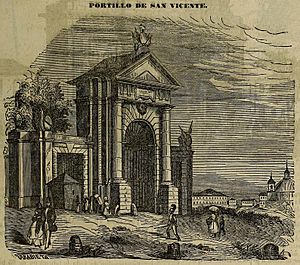Puerta de San Vicente facts for kids
The Puerta de San Vicente is a famous and impressive gate in Madrid, Spain. It stands in a place called Glorieta de San Vicente. The gate you see today was built in 1995. It looks just like the original gate, which was designed by a famous architect named Francesco Sabatini and stood there from 1775 to 1892.
Contents
A Look Back: The Gates of San Vicente
Madrid has had several gates named San Vicente throughout its history. These gates were important entrances to the city.
The First Gate (1726)
Around 1726, the mayor of Madrid, the Marquis of Vadillo, asked an architect named Pedro de Ribera to build a grand gate. This new gate replaced an older, worn-out one called "del Parque." The gate had three arches and was decorated with a statue of San Vicente, which is how it got its name. People also sometimes called it the "La Florida" gate.
Sabatini's Gate (1775)
In 1770, the first gate was taken down. This happened because the area around it was being rebuilt to make it easier to get to the Royal Palace. Soon after, King Carlos III asked Francesco Sabatini to design a brand new gate. This new gate would be the main entrance to the city from the new Paseo de La Florida.
Sabatini's gate was finished in 1775. It was placed closer to the river than the first one. This gate had one main arch and two smaller side openings. It was built using strong granite and limestone. The main arch had two fancy columns on the outside and two flat columns (called pilasters) on the inside. On top, it had a triangular decoration with military symbols. The smaller side openings also had military symbols.
Next to this gate, there used to be a fountain called the Fuente de los Mascarones, which was there until 1871. Later, a building for washerwomen was built nearby, but it was removed by 1938.
Why the Gate Disappeared
Around 1890 (some say 1892), Sabatini's gate was taken apart. This was done to help traffic flow better in the area. Sadly, the pieces of the original gate were lost and no one knows where they went. Some people think the stones were used to make cobblestones for roads. Others believe they were buried in a city storage area, but they were never found, even when people searched for them later.
The Gate Returns (1995)
In the 1990s, the Madrid City Council decided to bring the gate back! They wanted to put a new one in the exact same spot where the original had stood. So, a copy of the gate was made. An engineer named Juan A. de las Heras Azcona led this project.
The new gate was placed facing the city, which is the opposite direction of the original. To make this replica, they used concrete covered with grey granite and limestone. They even used some of the original stone moldings that were still around. They also looked at the original plans and an old photograph from 1890 to make sure it looked exactly right. The beautiful decorations on the new gate were made by José Luis Parés Parra.
See also
 In Spanish: Puerta de San Vicente para niños
In Spanish: Puerta de San Vicente para niños
- List of post-Roman triumphal arches



